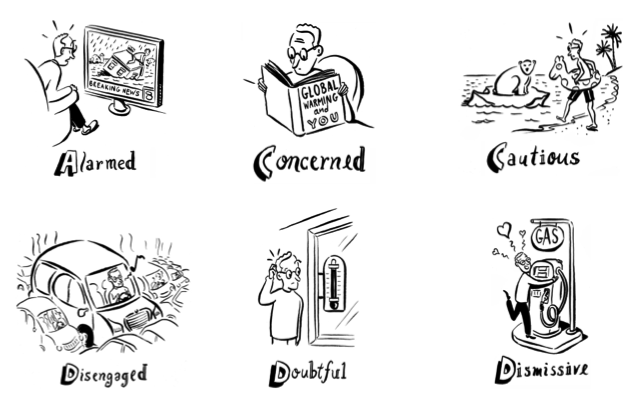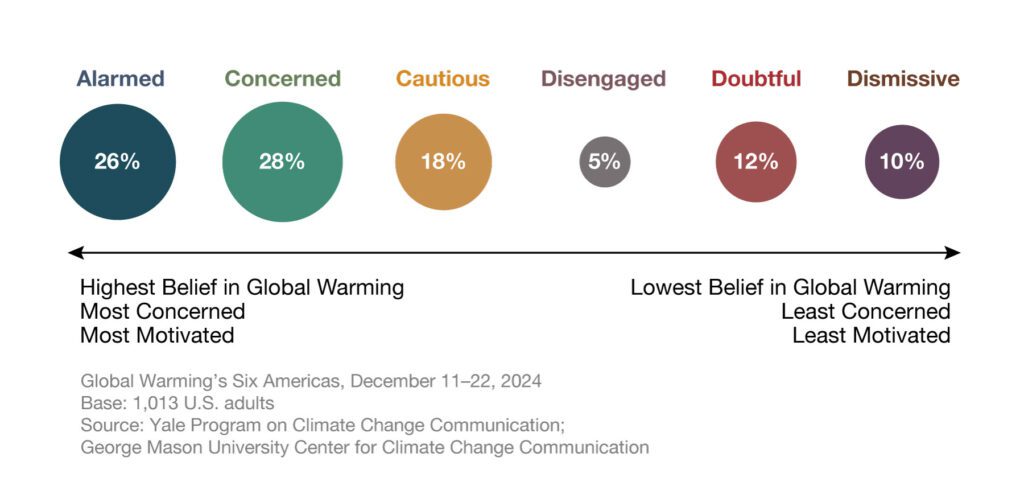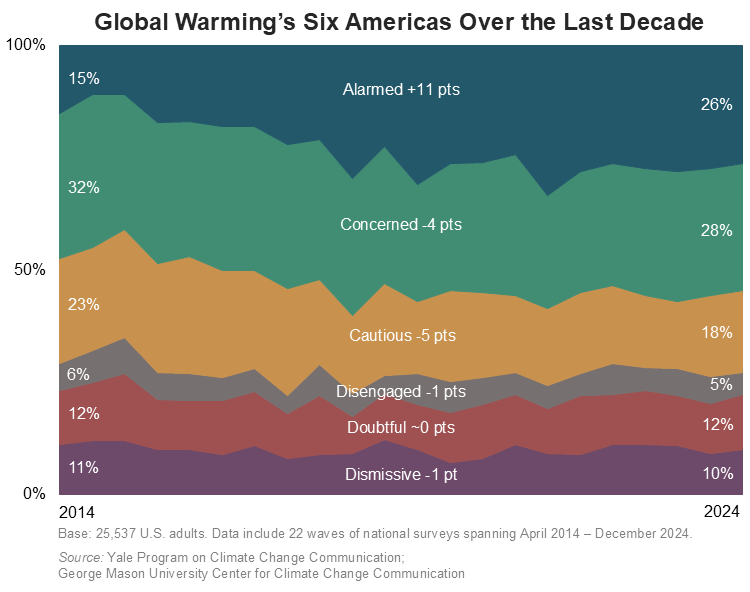Global Warming’s Six Americas
Artwork by Michael Sloan
One of the first rules of effective communication is to “know thy audience.” Climate change public engagement efforts must start with the fundamental recognition that people are different and have different psychological, cultural, and political reasons for acting – or not acting – to reduce greenhouse gas emissions. Our research has identified “Global Warming’s Six Americas”: six unique audiences within the American public that each responds to the issue in their own distinct way.
Want to know which of the Six Americas you are in?
Take the short Six Americas Quiz!
The Alarmed are convinced global warming is happening, human-caused, an urgent threat, and they strongly support climate policies. Most, however, do not know what they or others can do to solve the problem. The Concerned think human-caused global warming is happening, is a serious threat, and support climate policies. However, they tend to believe that climate impacts are still distant in time and space, thus climate change remains a lower priority issue. The Cautious have not yet made up their minds: Is global warming happening? Is it human-caused? Is it serious? The Disengaged know little about global warming. They rarely or never hear about it in the media. The Doubtful do not think global warming is happening or they believe it is just a natural cycle. They do not think much about the issue or consider it a serious risk. The Dismissive believe global warming is not happening, human-caused, or a threat, and most endorse conspiracy theories (e.g., “global warming is a hoax”).
The six audiences were first identified using a large nationally representative survey of American adults conducted in the fall of 2008. The survey questionnaire included extensive, in-depth measures of the public’s climate change beliefs, attitudes, risk perceptions, motivations, values, policy preferences, behaviors, and underlying barriers to action. The Six Americas are distinguishable on all these dimensions, and display very different levels of engagement with the issue.
The Six Americas Over Time
Over the past ten years, the Alarmed have grown more than any other audience, from 15% in 2014 to 26% in 2024 (+11 percentage points). Conversely, the Cautious have decreased in size the most during that time, from 23% in 2014 to 18% in 2024 (-5 percentage points). Additionally, the percentage of Americans who are either Alarmed or Concerned has increased from 47% in 2014 to 54% in 2024 (+7 percentage points). The Disengaged, Doubtful and Dismissive audiences have remained relatively similar in size over the past decade. Overall, Americans are becoming more worried about global warming, more engaged with the issue, and more supportive of climate solutions.
Since 2008, we have conducted many additional studies on these six audiences, including:
- Global Warming’s Six Americas, Fall 2024
- Changes in Global Warming’s Six Americas: An analysis of repeat respondents
- Global Warming’s Six Audiences around the world
- What do Americans want to know about climate change?
- Support for climate justice across Global Warming’s Six Americas
- Global Warming’s Six Americas, Fall 2023
- Which Republicans are worried about global warming?
- Global Warming’s Six Audiences: A cross-national comparison in nearly 200 countries and territories worldwide
- Global Warming’s Six Americas across age, race/ethnicity, and gender
- Global Warming’s Six Americas, December 2022
- Who is willing to participate in non-violent civil disobedience for the climate?
- Message Strategies for Global Warming’s Six Americas
- Global Warming’s Six Americas, September 2021
- Segmenting the climate change Alarmed: Active, Willing, and Inactive, 2021
- Global Warming’s Six Americas: A Review, 2021
- Climate Change in the Minds of U.S. News Audiences
- Which racial/ethnic groups care most about climate change?, 2020
- For the first time, the Alarmed are now the largest of Global Warming’s Six Americas, 2020
- Climate Activism: A Six-Americas Analysis Report, December 2020
- Americans are Increasingly “Alarmed” About Global Warming, 2019
- Latinos and Global Warming’s Six Americas, 2018
- Global Warming’s Six Americas and the Election, 2016
- Faith, Morality and the Environment: Portraits of Global Warming’s Six Americas
- Perception of the Health Consequences of Global Warming
- Climate Stability As Understood by Global Warming’s Six Americas
- Americans’ Actions to Limit Global Warming
- Screening tools: Survey instruments; instructions for coding and data treatment; and statistical program scripts
- Identifying like-minded audiences for climate change public engagement campaigns: An audience segmentation analysis and tool development
- Knowledge of Climate Change Across Global Warming’s Six Americas
- Global Warming’s Six Americas, 2009 (the original study)
The Six Americas framework is being used by climate educators and communicators throughout the United States, including local, state, and national governments, academic institutions, environmental organizations, businesses, faith groups, doctors and scientists, and the media. Interested in connecting with our Partnerships Program to discuss how to utilize the Six Americas framework in your work? Click here to learn more.
For a quick introduction to Global Warming’s Six Americas, please see our short video.


